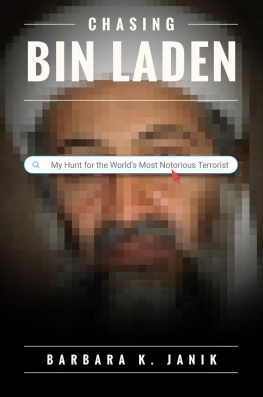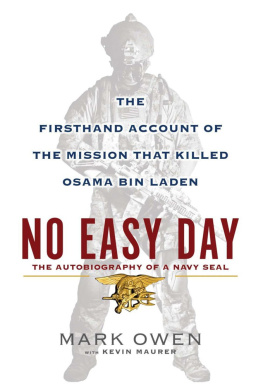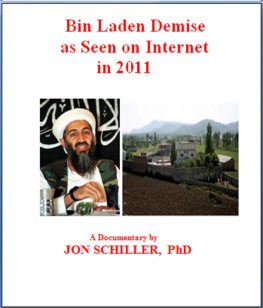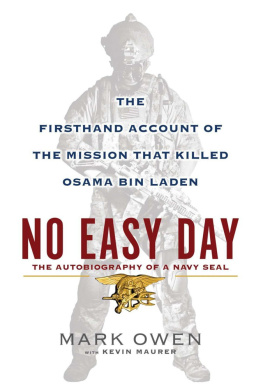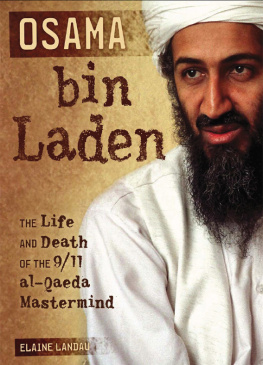OSAMA BIN LADEN:
THE LAST DAYS
BRANDON FRANKLIN HURST

Published by Cogito Media Group.
Copyright 2011 by Brandon Franklin Hurst
The reproduction or transmission of any part of this publication in any form or by any means, electronic, mechanical, recording, or otherwise, or storage in a retrieval system, without prior consent of the publisher, is an infringement of copyright law. In the case of photocopying or other reprographic production of the material, a license must be obtained from the Canadian Copyright Licensing Agency (Access Copyright) before proceeding.
ISBN: 978-1-926893-77-8
Cover design: Franois Turgeon
Text design and composition: Benjamin Roland
Cover photo:
Rex Features
Published in collaboration with Cogito America Inc
and Creative Media Funds LLC.
www.cogitomedias.com
Printed and Bound in the United States of America
Brandon Franklin Hurst
Perhaps he really is enjoying Paradise and the rewards that martyrs are traditionally believed to receive in the afterlife. But the truth is likely more prosaic: an anonymous grave at the bottom of the North Arabian Sea and a fast-closing chapter in the history books of the late 20th and early 21 st centuries. Whether justice comes in merely earthly terms or has eternal implications, it was served for Osama bin Laden on May 1, 2011.
TEN YEARS ON
KILL OR CAPTURE
THE TWO MODIFIED Black Hawk helicopters thudded softly through the night sky over the tense and lawless Taliban territory that lies between Afghanistan and Pakistan. Like most helicopters, a Black Hawk will usually make a thundering racket as its rotors whip through the air, but these were something new something so secret they had never been seen before. If it hadnt been of utmost importance for the mission, public knowledge of their existence would not have been risked.
Like the top-secret craft in which they flew, it is likely that little will be widely revealed about the twenty-five elite U.S. Navy SEALs who were deployed early that morning from the helicopters to their target destination, a compound in the town of Abbottabad a few miles from the capital of Pakistan. At some point during the mission, probably all of them recalled the time almost ten years earlier when two other aircraft had made iconic and terrible history, that time in broad daylight over the Manhattan skyline. It is inconceivable that between them they did not have friends and family who died in the terrorist attacks on the Twin Towers on September 11, 2001.
Their mission had been announced to them several weeks earlier, after which they had undergone a period of intense training in preparation. It was code-named Operation Neptune Spear. Navy SEALs are tasked with some of the toughest and most important work on the planet, but they recognized the special significance of this occasion. They were told, We think we found Osama bin Laden, one official recalled, and your job is to kill him. Their reaction had been to break into cheers and applause.
The Associated Press has cited other U.S. officials who have stated that the operation was a kill-or-capture mission, since the U.S. doesnt kill unarmed people trying to surrender. After the raid had successfully been completed, John O. Brennan, the White Houses counterterrorism advisor, told the press, If we had the opportunity to take bin Laden alive, if he didnt present any threat, the individuals involved were able and prepared to do that. Nevertheless, they conceded that it was clear from the beginning that whoever was behind those walls had no intention of surrendering. In other words, giving him the benefit of the doubt wasnt an option.
Altogether, a team of seventy-nine commandos were involved, including those twenty-five SEALs who went in on the ground and engaged the enemy. However, the circle had been kept deliberately small to avoid any unnecessary chance of compromise. Even high-level White House officials didnt know what was going on in the minutes after midnight on that day: President Obama had been fanatically careful not to endanger the men who flew into Pakistan under cover of night or to jeopardize the success of their crucial mission.
The SEALs flew from Bagram Air Base in Afghanistan to Jalalabad before making the crossing into Pakistan. They were equipped with versatile M4 carbines, as well as handguns and night-vision goggles. The state-of-the-art equipment was standard issue, but the aircraft in which they flew was something so cutting-edge that it had never been heard of before outside of elite military circles. The craft had been supplied by the so-called Night Stalkers, the 160th Special Operations Aviation Regiment. The Black Hawk helicopter was first acquired by the U.S. Army in 1978. The standard model has a crew of four two pilots, a flight engineer and a gunner and can hold up to 11 fully equipped soldiers. Its maximum takeoff weight is 22,000 pounds, and it is capable of carrying an additional 9,000 pounds of external load by sling. Its top speed is 184 mph. This already formidable craft, the workhorse of the Afghan and Iraq conflicts, had been upgraded with stealth capabilities probably the reason the mission got so far without Pakistani officials even realizing it. The alterations included a modified tail boom, plus a change in design and a covering on the rear rotors that would vastly reduce external noise. Helicopters make a very distinctive percussive rotor sound, which is caused by their rotor blades and if you can blend that down, of course that makes a noise that is much less likely to be heard and much more likely to blend into any background noise that there is, said Bill Sweetman, editor-In-Chief of Defense Technology International. They were also covered in a special radar-absorbent material, similar to the type used in stealth fighter planes. Dan Gour, a former Department of Defense official and vice president of the Lexington Institute, concluded that the result was something never seen before. This is a first, he commented. You wouldnt know that it was coming right at you. And thats whats important, because these are coming in fast and low, and if they arent sounding like theyre coming right at you, you might not even react until its too late That was clearly part of the success.
The Night Stalkers also provided three Chinook helicopters as backup which would be required after one of the Black Hawks went down in action and had to be destroyed. In addition, the Air Force had a full complement of search-and-rescue aircraft at the ready, and the SEALs would have the support of both drones and manned fighter jets.
The two helicopters flew in low over the mountains and in little moonlight to avoid detection before they reached their target. Their stealth modifications meant that they were almost silent until directly overhead, and harder to detect by radar than earlier models. Due to the extra weight of the stealth equipment, the SEALs own gear had been finely calculated to ensure the aircraft were not overloaded.
They arrived thirty minutes after midnight, local time as the Western world was going about its Sunday business with no knowledge of what was unfolding several thousand miles away. But then, even bin Laden and his closest neighbors had little warning until the Black Hawks were overhead. Nearby residents reported hearing a series of loud explosions a few minutes apart, and then one enormous explosion that rocked their houses. The lights went on and off and there was the sound of gunshots, but that didnt last long. Within a couple of minutes it had stopped. Some of the residents in the area had apparently been instructed to turn off their lights, raising the question of who had told them. The Pakistani security forces were the most obvious candidate, but the language used had been simple Pashto not the chief language of the area. It is possible that covert U.S. personnel were paving the way for their colleagues work.



